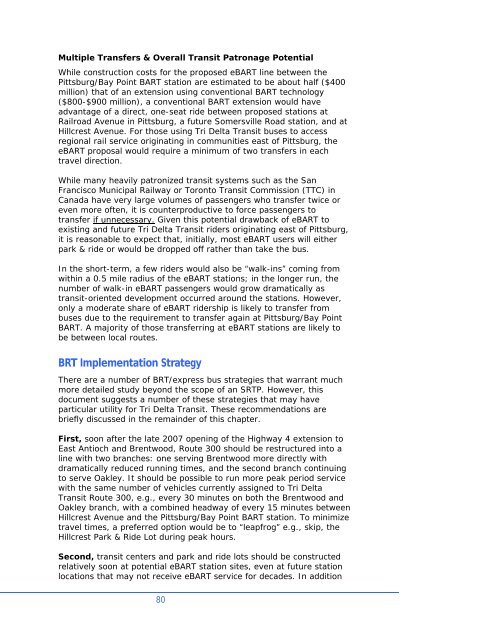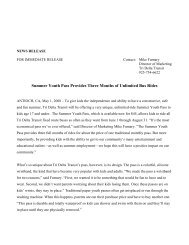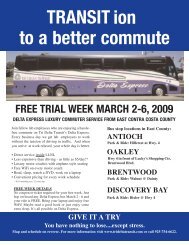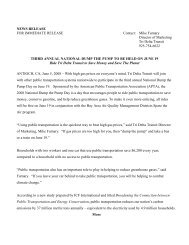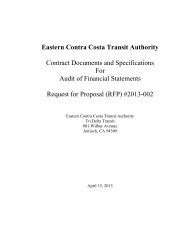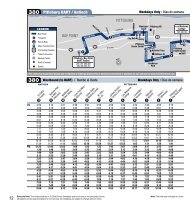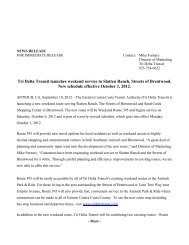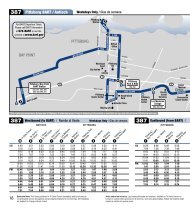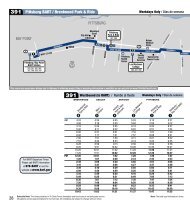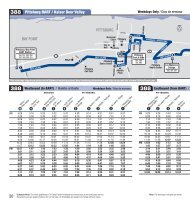to view Short Range Transit Plan FY 2007/2008 - Tri Delta Transit
to view Short Range Transit Plan FY 2007/2008 - Tri Delta Transit
to view Short Range Transit Plan FY 2007/2008 - Tri Delta Transit
You also want an ePaper? Increase the reach of your titles
YUMPU automatically turns print PDFs into web optimized ePapers that Google loves.
Multiple Transfers & Overall <strong>Transit</strong> Patronage PotentialWhile construction costs for the proposed eBART line between thePittsburg/Bay Point BART station are estimated <strong>to</strong> be about half ($400million) that of an extension using conventional BART technology($800-$900 million), a conventional BART extension would haveadvantage of a direct, one-seat ride between proposed stations atRailroad Avenue in Pittsburg, a future Somersville Road station, and atHillcrest Avenue. For those using <strong>Tri</strong> <strong>Delta</strong> <strong>Transit</strong> buses <strong>to</strong> accessregional rail service originating in communities east of Pittsburg, theeBART proposal would require a minimum of two transfers in eachtravel direction.While many heavily patronized transit systems such as the SanFrancisco Municipal Railway or Toron<strong>to</strong> <strong>Transit</strong> Commission (TTC) inCanada have very large volumes of passengers who transfer twice oreven more often, it is counterproductive <strong>to</strong> force passengers <strong>to</strong>transfer if unnecessary. Given this potential drawback of eBART <strong>to</strong>existing and future <strong>Tri</strong> <strong>Delta</strong> <strong>Transit</strong> riders originating east of Pittsburg,it is reasonable <strong>to</strong> expect that, initially, most eBART users will eitherpark & ride or would be dropped off rather than take the bus.In the short-term, a few riders would also be “walk-ins” coming fromwithin a 0.5 mile radius of the eBART stations; in the longer run, thenumber of walk-in eBART passengers would grow dramatically astransit-oriented development occurred around the stations. However,only a moderate share of eBART ridership is likely <strong>to</strong> transfer frombuses due <strong>to</strong> the requirement <strong>to</strong> transfer again at Pittsburg/Bay PointBART. A majority of those transferring at eBART stations are likely <strong>to</strong>be between local routes.BRT Implementation StrategyThere are a number of BRT/express bus strategies that warrant muchmore detailed study beyond the scope of an SRTP. However, thisdocument suggests a number of these strategies that may haveparticular utility for <strong>Tri</strong> <strong>Delta</strong> <strong>Transit</strong>. These recommendations arebriefly discussed in the remainder of this chapter.First, soon after the late <strong>2007</strong> opening of the Highway 4 extension <strong>to</strong>East Antioch and Brentwood, Route 300 should be restructured in<strong>to</strong> aline with two branches: one serving Brentwood more directly withdramatically reduced running times, and the second branch continuing<strong>to</strong> serve Oakley. It should be possible <strong>to</strong> run more peak period servicewith the same number of vehicles currently assigned <strong>to</strong> <strong>Tri</strong> <strong>Delta</strong><strong>Transit</strong> Route 300, e.g., every 30 minutes on both the Brentwood andOakley branch, with a combined headway of every 15 minutes betweenHillcrest Avenue and the Pittsburg/Bay Point BART station. To minimizetravel times, a preferred option would be <strong>to</strong> “leapfrog” e.g., skip, theHillcrest Park & Ride Lot during peak hours.Second, transit centers and park and ride lots should be constructedrelatively soon at potential eBART station sites, even at future stationlocations that may not receive eBART service for decades. In addition80


